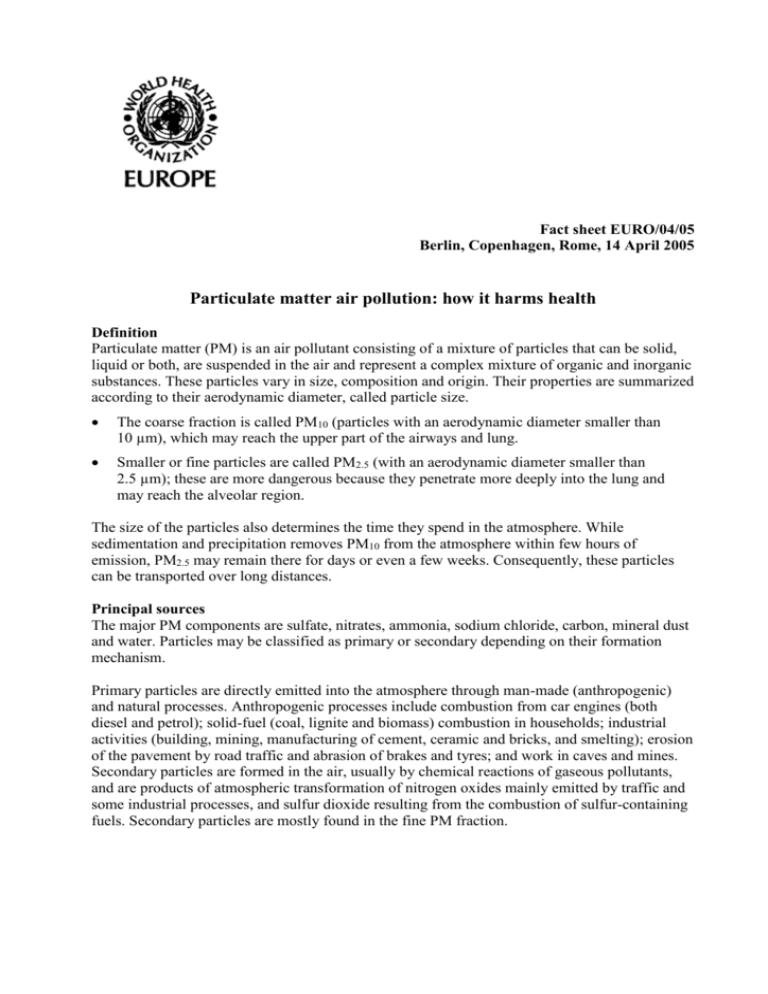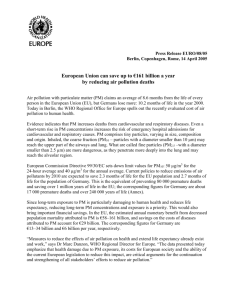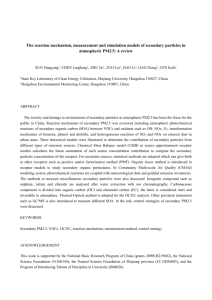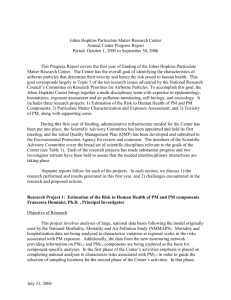Fact sheet 04/05
advertisement

Fact sheet EURO/04/05 Berlin, Copenhagen, Rome, 14 April 2005 Particulate matter air pollution: how it harms health Definition Particulate matter (PM) is an air pollutant consisting of a mixture of particles that can be solid, liquid or both, are suspended in the air and represent a complex mixture of organic and inorganic substances. These particles vary in size, composition and origin. Their properties are summarized according to their aerodynamic diameter, called particle size. The coarse fraction is called PM10 (particles with an aerodynamic diameter smaller than 10 µm), which may reach the upper part of the airways and lung. Smaller or fine particles are called PM2.5 (with an aerodynamic diameter smaller than 2.5 µm); these are more dangerous because they penetrate more deeply into the lung and may reach the alveolar region. The size of the particles also determines the time they spend in the atmosphere. While sedimentation and precipitation removes PM10 from the atmosphere within few hours of emission, PM2.5 may remain there for days or even a few weeks. Consequently, these particles can be transported over long distances. Principal sources The major PM components are sulfate, nitrates, ammonia, sodium chloride, carbon, mineral dust and water. Particles may be classified as primary or secondary depending on their formation mechanism. Primary particles are directly emitted into the atmosphere through man-made (anthropogenic) and natural processes. Anthropogenic processes include combustion from car engines (both diesel and petrol); solid-fuel (coal, lignite and biomass) combustion in households; industrial activities (building, mining, manufacturing of cement, ceramic and bricks, and smelting); erosion of the pavement by road traffic and abrasion of brakes and tyres; and work in caves and mines. Secondary particles are formed in the air, usually by chemical reactions of gaseous pollutants, and are products of atmospheric transformation of nitrogen oxides mainly emitted by traffic and some industrial processes, and sulfur dioxide resulting from the combustion of sulfur-containing fuels. Secondary particles are mostly found in the fine PM fraction. Fact Sheet EURO/04/05 page 2 Health hazards The systematic data assessment completed in 2004 by the WHO European Centre for Environment and Health, Bonn, indicates that: PM increases the risk of respiratory death in infants under 1 year, affects the rate of lung function development, aggravates asthma and causes other respiratory symptoms such as cough and bronchitis in children; PM2.5 seriously affects health, increasing deaths from cardiovascular and respiratory diseases and lung cancer. Increased PM2.5 concentrations increase the risk of emergency hospital admissions for cardiovascular and respiratory causes; and PM10 affects respiratory morbidity, as indicated by hospital admissions for respiratory illness. Relation of health effects to PM concentration In the last decade, studies of the short-term effects of PM, based on association between daily changes in PM10 concentrations and various health outcomes, were conducted in many cities in the WHO European Region, including Erfurt and Cologne in Germany. In general, results indicate that short-term changes in PM10 at all levels lead to short-term changes in acute health effects (Table 1). Effects related to short-term exposure include: inflammatory reactions in the lung, respiratory symptoms, adverse effects on the cardiovascular system and increases in medication use, hospital admissions and mortality. Table. 1. Short-term effects on health from 10-µg/m3 increases in PM10 concentration Health outcome Estimated percentage increase in risk per 10 µg/m3 PM10 (95% confidence interval) Estimates available for meta-analysis All-cause mortality 0.6 (0.4–0.8) 33 Mortality from respiratory diseases 1.3 (0.5–2.0) 18 Mortality from cardiovascular diseases 0.9 (0.5–1.3) 17 Hospital admissions for respiratory disease, people age 65 years and over 0.7 (0.2–1.3) 8 Source: Anderson HR et al. Meta-analysis of time series studies and panel studies of particulate matter (PM) and ozone (O3). Report of a WHO task group. Copenhagen, WHO Regional Office for Europe, 2004 (http://www.euro.who.int/document/e82792.pdf, accessed 8 April 2005). Fact Sheet EURO/04/05 page 3 Because long-term exposure to PM results in a substantial reduction in life expectancy, the longterm effects clearly have greater significance to public health than the short-term effects. PM2.5 shows the strongest association with mortality, indicating a 6% increase in the risk of deaths from all causes per 10-µg/m3 increase in long-term PM2.5 concentration.1 The estimated relative risk amounts to 12% for deaths from cardiovascular diseases and 14% for deaths from lung cancer per 10-µg/m3 increase in PM2.5.2 The effects related to long-term exposure include: increases in lower respiratory symptoms and chronic obstructive pulmonary disease, reductions in lung function in children and adults, and reduction in life expectancy, due mainly to cardiopulmonary mortality and probably to lung cancer Studies on large populations show a strong effect of PM2.5 on mortality, and have been unable to identify a threshold concentration below which ambient PM has no effect on health: a no-effect level. After a thorough review of recent scientific evidence, a WHO working group therefore concluded that, if there is a threshold for PM, it lies in the lower band of currently observed PM concentrations in the European Region. For more technical information contact: TECHNICAL INFORMATION: PRESS INFORMATION: Dr Michal Krzyzanowski Regional Adviser, Air Quality and Health WHO European Centre for Environment and Health, Bonn WHO Regional Office for Europe Bundeshaus, Görresstraße 15 D-53113 Bonn, Germany Tel.: + 49 228 209 4405. Fax: +49 228 209 4201 Email: mkr@ecehbonn.euro.who.int Ms Liuba Negru Press and Media Relations Officer WHO Regional Office for Europe Scherfigsvej 8, DK-2100 Copenhagen Ø, Denmark Tel.: +45 39 17 13 44. Fax: +45 39 17 18 80 E-mail: LNE@euro.who.int Ms Cristiana Salvi Technical Officer, Communication and Advocacy WHO European Centre for Environment and Health, Rome WHO Regional Office for Europe Via Francesco Crispi 10, I-00187 Rome, Italy Tel.: +39 06 4877543. Mobile: +39 348 0192305 Fax: +39 06 4877599 E-mail: csa@ecr.euro.who.int 1 Pope AC et al. Lung cancer, cardiopulmonary mortality, and long-term exposure to fine particulate air pollution. Journal of the American Medical Association, 287:1132–1141 (2002). 2 Pope AC et al. Lung cancer, cardiopulmonary mortality, and long-term exposure to fine particulate air pollution. Journal of the American Medical Association, 287:1132–1141 (2002); and Pope AC et al. Cardiovascular mortality and long-term exposure to particulate matter air pollution. Circulation, 109:71– 77 (2004).







